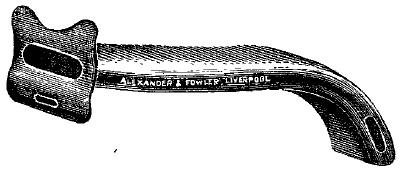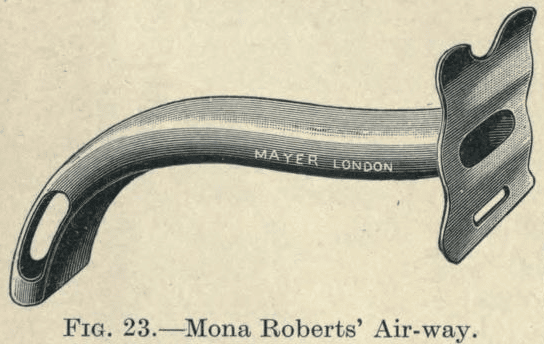Mona Roberts
Mona Dew Roberts (1878-1936) was a Welsh General Practitioner and anaesthetist
Very little is known about Dr Mona Dew Roberts apart from an obituary in the British Medical Journal and Medical Directory entries.
She was a recognized lecturer on midwifery for the Central Midwives Board, and medical officer of the Liverpool ante-natal clinics as well as assistant anaesthetist to Liverpool Royal Infirmary.
Her name lives on with the Mona Roberts oropharyngeal airway she described in a 1916 article in the Lancet
Biography
- Born in May 1878, in Manchester; daughter of Dr John Roberts (1837-1913), physician to Manchester Royal Infirmary; Dew was her mother’s maiden name (Mary Elizabeth Dew (1849-1909))
- Raised in Menai Bridge, Anglesey, Wales
- 1908 – Graduated M.B., B.S. Lond. from the London School of Medicine for Women
- She held various posts in London: clinical assistant to the Evelina Hospital for Children; junior resident obstetrical assistant and medical clinical assistant to the Royal Free Hospital; and resident assistant medical superintendent, St. Pancras South Infirmary.
- 1913 – Entered into private practice with Dr Mary Davies at 30 Princes Avenue, Liverpool
- 1916 – Honorary visiting physician to the Liverpool Children’s School of Recovery and the Edgehill Training College; Assistant Anaesthetist to Liverpool Royal Infirmary – performing open ether for all the gynaecological operations performed by Dr William Blair-Bell (1871-1936) – founder of the Royal College of Obstetricians and Gynecologists in 1929
- Died on April 17, 1936 in Liverpool following a stroke
Medical Eponyms
Mona Roberts Airway (1916)
The Mona Roberts oropharyngeal airway device is a metal piece used for keeping air passages open during anaesthesia. It is a flattened anatomically curved tube, holes at the side and the dorsal surface near the distal end of the tube, and a flange at the proximal end to prevent overinsertion.
A distinctive feature of the Roberts airway is an upright flange that is rippled rather than flat, and has a crescent-shaped notch in the top edge to accommodate the patient’s nose.
The Mona Roberts airway was manufactured from 1916-1946

The tube is modelled on one used in the United States and by Dr Mott of Stoke and modified by Dr Blair Bell who first suggested its use to me It is a flat hollow metal tube 4″ in length with a flange at the external end, the upper edge of which is hollowed out to fit beneath the nostrils, whilst in the lower half of the flange there is a small slit, through which, if required, a piece of tape can be threaded and tied round the patient’s neck The tube is so curved as to comfortably pass over the tongue into the pharynx
Mona Roberts, 1916

Sir Frederic Hewitt was the first to perceive the advantage in certain types of obstructed respiration of the appliance which he invented and named the artificial air-way. It consists of a grooved metal ring from which passes a curved rubber tube sufficiently thick in its walls to prevent approximation between the tongue and the palate.
The invention served its immediate purpose very well, but is difficult to keep clean. An improved pattern of this useful appliance has been devised by Mona Roberts in metal; and in my experience it answers better than Hewitt’s earlier pattern.
Hewitt, 1922
Major Publications
- Roberts MD. A case of haemochromatosis, or pigmentary cirrhosis of the liver with glycosuria. Br Med J. 1911 Nov 11;2(2654):1248.
- Roberts MD. Tetanic spasms occurring in a case of chronic ulceration of the leg. Lancet 1912; 179(4633): 1608-1609
- Roberts MD. New Inventions: An oral tube in open ether anæsthesia. Lancet 1916; 188(4869): 1060
References
Biography
- Mona Dew Roberts, M.B. Br Med J 1936; 1: 919
Eponymous terms
- Frost PM. Yet another airway. The history of anaesthesia society proceedings 1993; 13: 12-14
- Calverley R. A rare bit of Welsh History. Anesthesia History Association Newsletter 1993; 11(4): 2
- Medical Instrument – Mona Robert Airway Device. Museums Victoria
- Roberts Airway. Woods Library Museum
[cite]
Emergency Medicine Registrar at Sir Charles Gairdner Hospital. BM BS, BMed Sci, MMed Sci from the University of Southampton.
Enjoying life in Australia currently with the view to returning to the UK to train in Anaesthetics and Intensive Care Medicine.

